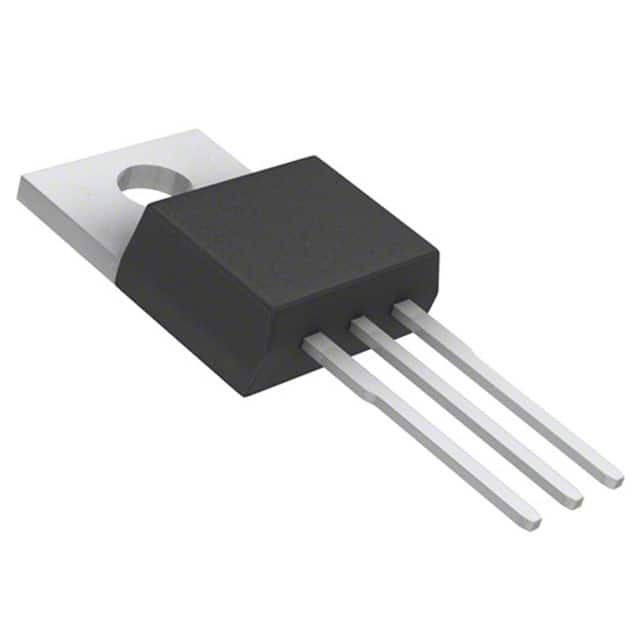BDX54ATU
Introduction
BDX54ATU is a power transistor that belongs to the category of bipolar junction transistors (BJTs). It is commonly used in various electronic applications due to its high power handling capabilities and reliability. This entry provides an overview of the BDX54ATU, including its basic information, specifications, pin configuration, functional features, advantages and disadvantages, working principles, application field plans, and alternative models.
Basic Information Overview
- Category: Bipolar Junction Transistor (BJT)
- Use: Power amplification and switching applications
- Characteristics: High power handling, low saturation voltage, and high current gain
- Package: TO-220AB
- Essence: Power transistor for medium to high power applications
- Packaging/Quantity: Typically available in reels or tubes containing multiple units
Specifications
- Collector-Base Voltage (VCBO): 100V
- Collector-Emitter Voltage (VCEO): 100V
- Emitter-Base Voltage (VEBO): 5V
- Collector Current (IC): 8A
- Power Dissipation (PD): 80W
- Transition Frequency (fT): 2 MHz
- Operating Temperature Range: -65°C to 150°C
Detailed Pin Configuration
The BDX54ATU transistor has a standard TO-220AB package with three leads: 1. Collector (C): Connected to the positive supply voltage 2. Base (B): Input control terminal 3. Emitter (E): Connected to the ground or load
Functional Features
- High current gain for efficient power amplification
- Low saturation voltage for minimal power loss during switching
- Robust construction for reliable performance in demanding environments
Advantages and Disadvantages
Advantages
- High power handling capability
- Low saturation voltage
- Suitable for medium to high power applications
Disadvantages
- Relatively larger package size compared to smaller SMD transistors
- Higher thermal resistance due to the TO-220AB package
Working Principles
The BDX54ATU operates based on the principles of bipolar junction transistors, where the flow of current between the collector and emitter is controlled by the base current. When a small signal is applied to the base, it modulates the larger current flowing from the collector to the emitter, allowing for amplification or switching functions.
Detailed Application Field Plans
The BDX54ATU is commonly used in the following applications: - Audio amplifiers - Power supplies - Motor control circuits - Switching regulators - LED drivers
Detailed and Complete Alternative Models
Some alternative models to BDX54ATU include: - TIP31C - TIP32C - 2N3055 - MJL3281A - MJL1302A
In conclusion, the BDX54ATU is a versatile power transistor suitable for a wide range of medium to high power applications. Its robust construction, high power handling capabilities, and reliability make it a popular choice among electronic designers and hobbyists.
[Word Count: 409]
Senaraikan 10 soalan dan jawapan biasa yang berkaitan dengan aplikasi BDX54ATU dalam penyelesaian teknikal
What is the BDX54ATU transistor used for?
- The BDX54ATU is a high power NPN Darlington transistor commonly used in applications requiring high current and voltage switching.
What are the key specifications of the BDX54ATU transistor?
- The BDX54ATU has a maximum collector-emitter voltage of 100V, a continuous collector current of 8A, and a total power dissipation of 80W.
Can the BDX54ATU be used for motor control applications?
- Yes, the BDX54ATU is suitable for motor control applications due to its high current handling capability and voltage rating.
How can the BDX54ATU be used in audio amplifier circuits?
- The BDX54ATU can be used as a driver or output stage in audio amplifier circuits, especially in high-power audio applications.
What are the typical operating conditions for the BDX54ATU?
- The BDX54ATU operates within a temperature range of -65°C to 150°C and is designed for use in demanding industrial and automotive environments.
Is the BDX54ATU suitable for use in switching power supply designs?
- Yes, the BDX54ATU can be used in switching power supply designs where high current and voltage requirements are necessary.
What are the recommended heat sink requirements for the BDX54ATU?
- It is recommended to use a proper heat sink to ensure the BDX54ATU operates within its specified temperature limits, especially in high-power applications.
Can the BDX54ATU be used in pulse-width modulation (PWM) circuits?
- Yes, the BDX54ATU can be utilized in PWM circuits for controlling motors, lights, and other high-power loads.
Are there any common failure modes associated with the BDX54ATU?
- Common failure modes include thermal runaway due to inadequate heat dissipation and overvoltage stress leading to breakdown.
Where can I find detailed application notes for using the BDX54ATU in technical solutions?
- Detailed application notes and circuit examples for the BDX54ATU can be found in the manufacturer's datasheet and application guides, providing comprehensive guidance for various technical solutions.


